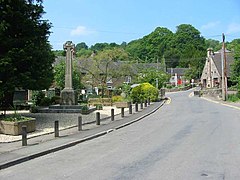
Leek is a market town and civil parish in the county of Staffordshire, England, on the River Churnet. It is situated about 10 miles (16 km) north east of Stoke-on-Trent. It is an ancient borough and was granted its royal charter in 1214.

Alton is a village in Staffordshire, England, The village is noted for the theme park Alton Towers, built around the site of Alton Mansion, which was owned by the Earls of Shrewsbury, and designed by Augustus Pugin. In the 1914 map by Whiston, there were copper works in the village.

The River Churnet is a river in Staffordshire, England. It is a tributary of the River Dove.
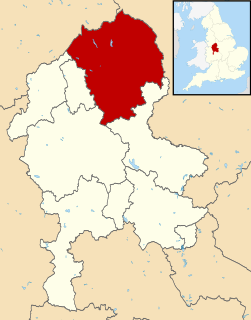
Staffordshire Moorlands is a local government district in Staffordshire, England. Its council, Staffordshire Moorlands District Council, is based in Leek and is located between the city of Stoke-on-Trent and the Peak District National Park. The 2001 census recorded the population as 94,489.
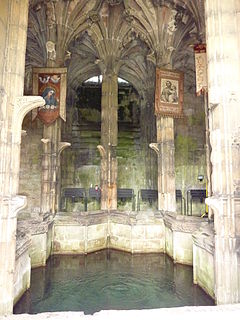
Holywell is the fifth largest town and a community in Flintshire, Wales. It lies to the west of the estuary of the River Dee. The community includes Greenfield.

The Churnet Valley Railway is a preserved standard gauge heritage railway to the east of Stoke-on-Trent in Staffordshire, England, that operates along a part of the former North Staffordshire Railway's (NSR) Churnet Valley Line. Regular services travel between the two main stations at Cheddleton and Kingsley and Froghall. There is an intermediate station at Consall. Some trains also head beyond Cheddleton to Leek Brook Junction and on to Ipstones, but Ipstones station is not in use.
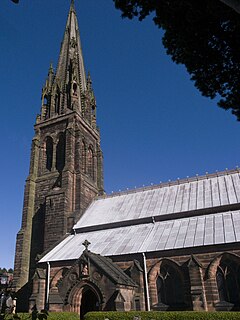
Cheadle is a market town and civil parish in the Staffordshire Moorlands District of Staffordshire, England, with a population of 12,165 as of the 2011 census. It is located between Uttoxeter, Leek, Ashbourne and Stoke-on-Trent.
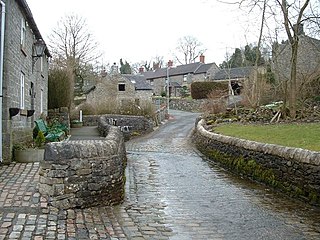
Butterton is a small village in the Staffordshire Peak District of England. It overlooks the Manifold Valley and Ecton Hill, which rises 1,212 feet above sea level. Butterton lies 5 miles east of Leek and roughly 8 miles from Alton Towers theme park. The village is just west of the limestone area, and so is mainly built of local sandstone. It contains a Grade II listed church. In the centre of Butterton there is an unusual ford where the Hoo Brook runs along the village street.

Ipstones is a village and civil parish in the north of the English county of Staffordshire.
Kingsley and Froghall railway station is a former railway station of the North Staffordshire Railway (NSR) that is now a preserved station on the Churnet Valley Railway in Staffordshire, England.

Alton Station, previously called Alton railway station and Alton Towers railway station, is holiday accommodation and an abandoned railway station in Staffordshire, managed by the Landmark Trust. Opened in 1849 by the North Staffordshire Railway, the station was part of the Churnet Valley line and served the village of Alton and the country estate at Alton Towers. In 1954, the station was renamed Alton Towers. After being closed in 1965, Alton Towers was purchased by Staffordshire County Council in 1969 to curtail persistent vandalism of the station building, and in 1979 was sold to the Landmark Trust, who renamed the site to Alton Station and converted the former station buildings into holiday accommodation.

Froghall is a village situated approximately ten miles to the east of Stoke-on-Trent and two miles north of Cheadle in Staffordshire, England. Population details as taken at the 2011 Census can be found under Kingsley. Froghall sits in the Churnet Valley, a beautiful and relatively unspoilt part of Staffordshire. There are some excellent and challenging walks in the area, many of which encompass the area's historic development by the coal, ironstone, copper and limestone industries.

Denstone is a village and civil parish situated between the towns of Uttoxeter in East Staffordshire and Ashbourne in Derbyshire. It is located next to the River Churnet. The All Saints village church, vicarage and school were built by Sir Thomas Percival Heywood, 2nd Baronet in the mid 19th century. Denstone College is situated to the west of the village.

Oakamoor railway station is a closed railway station in the Churnet Valley, Staffordshire. The station was opened in 1849 as part of the Churnet Valley Line constructed by the North Staffordshire Railway. Serving the village of Oakamoor the station remained open until 1965 when all services were withdrawn, A little north of the station, freight traffic from Oakamoor Sand Sidings continued until 1988.

Denstone railway station is a former station of the North Staffordshire Railway's (NSR) Churnet Valley Line which served the village of Denstone in Staffordshire.
The Churnet Valley line was one of the three original routes planned and built by the North Staffordshire Railway. Authorised in 1846, the line opened in 1849 and ran from North Rode in Cheshire to Uttoxeter in East Staffordshire. The line was closed in several stages between 1964 and 1988 but part of the central section passed into the hands of a preservation society and today operates as the Churnet Valley Railway.
The Stoke to Leek line is a mothballed railway route, which up until 1988 was used by BR freight trains to reach the quarries at both Cauldon Lowe and Oakamoor.
Leek railway station is the proposed and future terminus of the Churnet Valley Railway and is currently awaiting construction. It will be the second railway station in Leek.
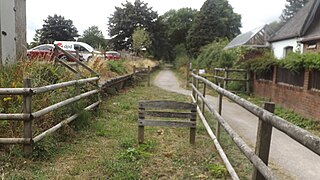
The Biddulph Valley line was a double tracked line that ran from Stoke-on-Trent to Congleton. The line was named after the town of the same name as it ran via the Staffordshire Moorlands and covered areas of East Staffordshire and Cheshire.

The Old Furnace is a colloquial name given to an historic site in Oakamoor, Staffordshire, England, that supported the development of medieval and post-medieval iron smelting.
